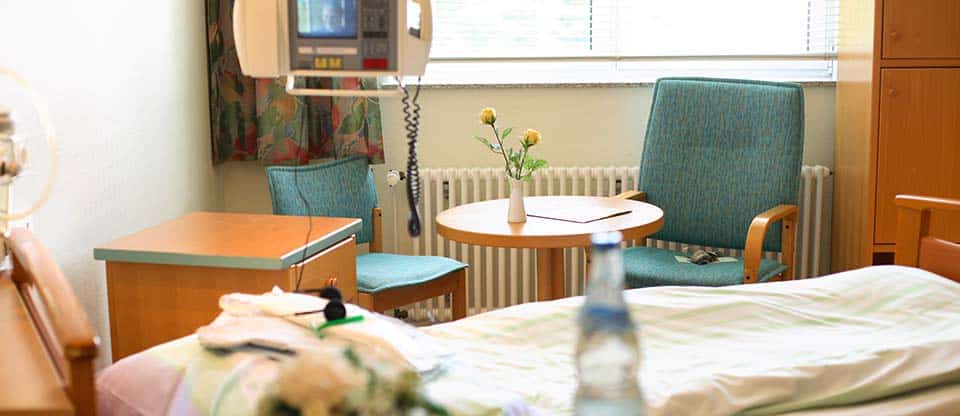Diagnostics
- x-ray
- Perfusion scintigraphy
- CT scan
- Magnetic resonance imaging
- Positron emission tomography
- Pleuropuncture
- Bronchoscopy
- Mediastinoscopy
- Thoracoscopy
- Diagnosis and surgery for lung cancer (bronchial carcinoma)
- Examination of the chest (thoroscopy)
- Sampling from the mediastinum (mediastinoscopy under video camera control)
- Taking samples of lung tissue (lung biopsy)
- Taking samples of pleural tissue (pleural biopsy)
- Partial lung resection
- Removal of a lung lobe (lobectomy)
- Removal of the lung (pneumectomy)
- Methods that preserve the lung tissue (parenchyma) as much as possible, plastic reconstruction (bronchoplasty) and angioplasty operations (bypass, replacement)
- Atrial and pericardial resection
- Resection of the chest wall
Conservative and surgical therapy
- Removal of metastases in the lungs
- Treatment of inflammatory / purulent diseases of the lungs (empyema), sternum, chest wall, chest and mediastinum
- Treatment for accumulation of blood (for example, after a broken rib) in the chest area (hematothorax)
- Treatment for accumulation of fluid in the pleural cavity, such as pleurodesis for pleural cancer
- Decrease in lung volume due to swelling of the lungs (pulmonary emphysema)
- Removal of mediastinal tumors (eg, thymoma in Myasthenia gravis, bronchogenic cysts)
- Treatment of stenoses in benign and malignant tumors of the trachea
- Diaphragm surgeries (tension, hernias, stitching of tears)
- Operations for benign and malignant diseases of the parietal and visceral pleura
- Operations for benign and malignant tumors of the chest wall (neurinoma, fibroma, sarcoma)
- Treatment of pulmonary tuberculosis and pleural diseases
- Visual examination of the bronchial system (bronchoscopy with a flexible and rigid endoscope) followed by endobronchial removal of tumors and stent implantation
- Treatment of complex thoracic injuries (in cooperation with the Clinic for Emergency Surgery)
Operations with a minimally invasive method
Compared to traditional abdominal operations, modern minimally invasive methods are gaining more importance in surgery and are performed in approximately 30 % cases. With special tools, only 2-3 small incisions 1.5-2 cm long are made. With the help of a special camera, the doctor monitors the process of the operation on the monitor. The method allows to prevent postoperative complications and ensures the speedy healing of the wound, which leads to a quick recovery and discharge from the clinic.
Professor, MD, PhD
Head of the Clinic for General, Visceral, Thoracic and Endocrine Surgery
Head of the Clinic for General, Visceral, Thoracic and Endocrine Surgery
Video
Precise mathematical calculations for the most effective radiation therapy.
Radiation therapy without harm to healthy tissue? In our clinic it is possible!
Guaranteeing optimal results in oncology - an interdisciplinary approach in radiotherapy.
A complete cure for cancer is possible thanks to the high precision of radiation therapy.
How does a radiation therapy and radiation oncology clinic work in Germany? (12+)
“Treating diabetes without insulin is possible!” - Professor Martin proves.
We reduce weight, pressure, sugar levels competently - a program awarded with an international scientific award
The right diet for diabetes is tasty, simple, effective and without the need for medications (12+).
The best diabetes doctor in Germany about the innovative program together with Deutsche Klinik Allianz.
Combined oncology treatment at the Bethesda Clinic is comprehensive and effective.
A unique center for thyroid surgery under the guidance of a leading specialist in Europe.
Why the clinic takes on complex medical cases and successfully handles them - says Dr. Zimon.
The best operating ophthalmologist in Germany about his experience of working with foreign patients.
Ophthalmologist Dr. Thomalla is an innovator who performed the world's first cornea transplant (6+).
About the treatment of reflux - the best surgeon in Germany Konstantinos Tsarras
Request appointment
Useful links














